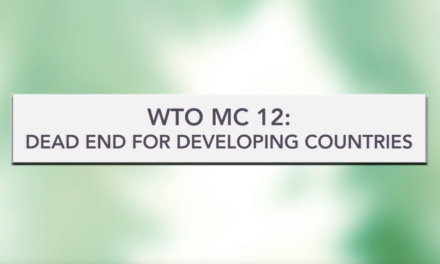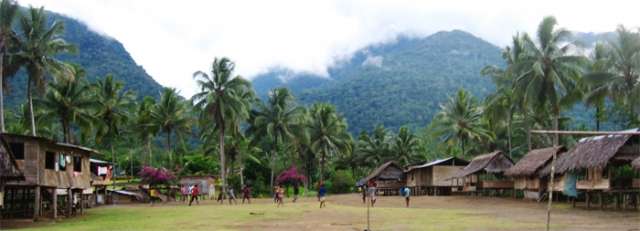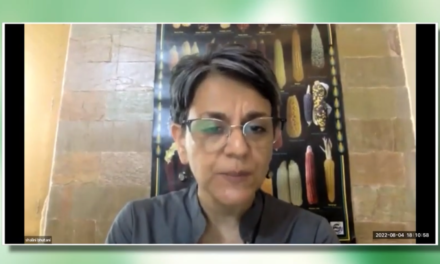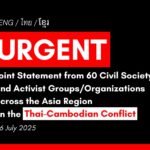On April 24, 2010, the Universal Declaration of The Rights of Mother Earth was proposed and launched at the People’s Conference on Climate Change and the Rights of Mother Earth in Cochabamba, Bolivia. Ensuring the rights of Mother Earth, the Declaration recognizes that all living beings have the responsibility to uphold the balance of the natural world and protect Mother Earth’s harmonious functioning.
In this panel discussion on The Rights of Mother Earth, organized by Thailand’s working group for Climate Justice (TCJ) in Bangkok during the UNFCCC intersessional 5 May 2011, Elizabeth Peredo Beltrán, director of the Solon Foundation in Bolivia, shared her knowledge and experience concerning the progress of the concept of the Rights of Mother Earth as it has started to gain a place in international discourse on development and climate change. The following is a summary of her presentation and the following discussion with Dr Sriprapa Petchmeesi and Prue Odochao.
Amid the increasing frequency and severity of climate change induced disasters, the ability to remember and recognize humans’ contributions to climate change is one of the first steps in ensuring real environmental reparation. Under the capitalist system, humans commodify and exploit nature without realizing the interdependence between all living beings on a global scale. Mainstream development paradigms have become one dimensional, focused only on increasing economic wealth, which could be pursued endlessly by technological change. Dominant institutions like the World Trade Organization also facilitate the process of commoditization, aimed at fulfilling corporate interests. In this way, major development programmes are biased towards allowing money and power to become drivers for a so-called better world. The main indicator to measure development — GDP — clearly does not account for all the problems and costs from human activities. For example, mineral extraction results in higher GDP but pollution and poor living standards of mine workers have been simply ignored in GDP accounting.
Human rights movements began as a reaction to the atrocities by the Nazi regime, but we cannot afford another tragedy to find consensus for defending our environment and our lives. Each year, more than 9 billion metric tonnes of green house gases (GHGs) have been released into the atmosphere and each year 350,000 people have died because of climate change. This number could increase to 5 million in the next 10 years with current GHG emission levels. In order to mitigate the impending disasters, humans must reconnect with Mother Earth and bring back the notions of belonging, gratitude, and common destiny. As a small part of the natural world, we cannot and do not have the right to go beyond the limits of Mother Earth, who is our home and life provider rather than a mere resource.
Over 2007 – 2009, Ecuador and Bolivia have taken the initiative to recognize the Rights of Mother Earth in their national constitutions by replacing “development” with the concept of “living well” and aiming at resource redistribution in a democratic and equitable way. However, national recognition is not enough to address a global crisis. These ideas were taken further to the 2010 World People’s Conference on Climate Change and Rights of Mother Earth in Cochabamba, Bolivia, where global citizens joined to discuss what can be done about climate change and related crises. The conclusion was clear; the only way to ensure humankind’s continuity is to recognize the Rights of Mother Earth, whom all living beings depend upon. The recent crisis at the nuclear power plant in Japan provided an example of how humanity’s quest for growth and development has infringed on these Rights and resulted in a catastrophe.
The proposal of Mother Earth Rights identifies that the rights of every being is limited by others’ rights but all must worked-out and balanced in a way that maintains the Rights of Mother Earth. All humans have to take responsibilities for past violations and future protection of Mother Earth Rights, especially those that have caused more environmental damage. A number of UN Resolutions already reflect similar key values. The World Conference on Indigenous Peoples and the Second Committee on Sustainable Development recognize that humans are a part of the natural world, not owners of it. The newly acknowledged human right to water and sanitation could also be easily implemented into the Rights of Mother Earth. Indigenous societies already possess the knowledge to live harmoniously with nature and they are reclaiming those rights after years of struggle to defend their status and traditional wisdom from being systematically undermined. In 2009, for example, indigenous peoples of the Amazonian area attempted to bring problems of environmental degradation to the International Court of Justice. More citizens and activists worldwide are starting to join in. December 2009 marked one of the first litigations under the Ecuadorian constitution to identify BP, a multinational oil and gas company, as the violator of the rights of nature for its oil spills. Feminism has also taught us that what we consider personal issues, such as caring for nature and protecting local knowledge, are political issues. Therefore we need to encourage creativity in challenging the system that is destroying Mother Earth and imagining a better future. The idea of the Rights of Mother Earth cannot be left as a matter of individual conscience, so now is the time to adopt this new paradigm to create new politics, systems, and governance to put environmental protection into practice, especially at the local level. These steps would not be some regression to an ancient past, but a move forward to a sustainable future.
Reflecting on how this concept relates to the context in Asia, Dr Siprapa Petchmeesi, a human rights expert from Thailand and member of the ASEAN Intergovernmental Commission on Human Rights, revealed that she, too, agreed that there exists a shared destiny between all beings, including humans. In her remarks she commented that there is some common ground between human rights and Mother Earth Rights, and the link between rights and responsibilities cannot be separated. However, we are facing a new form of colonization, in which colonizers, often in the form of multinational corporations, indirectly exert power and control through governments and the laws. The concept of accountability must play a role to prevent companies and other legal entities from externalizing their costs to the environment.
Rights of Mother Earth are inextricably linked to the rights to self-determination, indigenous peoples’ rights, and the right to life. On the note of justice, however, we still need to find common grounds between ecological, economic, and political justice, she said.
Dr Sriprapa added that human rights movements are still facing the challenges of raising awareness and promoting the notion of human rights in Asia. Thus, the proposal of the Rights of Mother Earth will inevitably encounter similar challenges. It is necessary to bring the Rights of Mother Earth into the public sphere and the education system in order to create more open discussions and to reach a wide range of audiences.
Continuing the discussion, Prue Odecha, a member of Thailand’s Land Reform Network, shared his view that the Rights of Mother Earth overlap with the beliefs and value system of indigenous peoples. Khun Prue explained that the respect for Mother Earth is embedded in the daily lives of forest peoples, including the Karen, of which he is a member. For them, there exists a complex web of hierarchies within nature but every being is a part of one family. Water, land, hills are respected and given the title of Mother, and Mother Earth is known in their tradition as Grandmother Earth, who keeps the balance of the world and governs this sacred system of interaction between the Mothers and their Children. Humans’ spirits are also shared with other living beings like tigers, elephants, and even dung beetles. Their destruction, thus, signifies an end to human’s life. This knowledge of the interconnectedness of life inspires imagination about how we should lead our lives. However, the current economic, political, and legal systems disregards environmental integrity and frustrates the linkages between natural beings. For example, separate governmental agencies (i.e. Department of Forest and Department of Water Resources), each working on different “pieces” of the forest, preclude a holistic understanding of the forest and undermine indigenous peoples’ rights to live harmoniously with nature.
Khun Prue pointed out that the Rights of Mother Earth proposal signifies the traditional imagination, which perceives the world through its value and not its price. If this concept was introduced in Thailand, he said, we could have a better understanding of how to live well and harmoniously with Mother Earth. The main challenge is that Thai laws, having derived from the principal architects of current government policies around the world, are not representative of the imagination of traditional cultures. Bolivia is using the narrative of the Rights of Mother Earth to confront capitalism head on and Thailand will need to adopt similar undertakings.
Echoes from participants of the seminar showed agreement with the proposal for Rights of Mother Earth. A group of indigenous as well as Thai and Lao people explained that it is part of their way of life to show respect and to make occasional sacrifices to Mother Earth. However, humans nowadays simply blame nature or others when a disaster occurs without reflecting on their own activities. The prevailing system also promotes disengagement between the human and natural world while granting corporations the power and legitimacy to take care of societal needs. Jao Pah (Lord of the Forest) has already lost his authority to the Department of Forest, which approves of corporations’ legal entity and rights more than those of local villagers and indigenous groups.
Other participants questioned how to operationalize this seemingly abstract concept. How can it translate to access to food and sanitation and create an actual change? How can the Rights of Mother Earth be used to stop the current developmental trend while answering other grave problems such as poverty? One seemingly radical, yet possible measure might be the reversal of private ownership to communal resource – a system in which traditional societies have upheld for thousands of years. However, some are still at a loss as to how this initiative can be taken forward in the face of pervasive land-grabbing and violence.
In the concluding statements, Dr Sriphapha added that some precedents have already been set to protect the environment in ASEAN, and future inclusion of the Mother Earth Rights into the ASEAN constitution would provide a big stride towards change.
In sum, the concept of the Rights of Mother Earth is not new, although its narrative and introduction to the global discourse on sustainable development might be, and may take some time to be recognized. The operationalization of this concept will need to take into account immediate needs while aiming at a long-term goal of environmental sustainability. The recognition of the Rights of Mother Earth can open more areas to fight against the current governing system, but before real change can take place, it should be pushed to prominence by experienced and resourceful groups like human rights activists, the media, and especially by indigenous peoples who can lead by example of how to live harmoniously with the nature. The reality is that we have to struggle with weak human rights against myths of endless development and laws that are created to commoditize and appropriate resources. The priority now is to build on this narrative and extend the understanding of the Rights of Mother Earth throughout the world.







![[IN PHOTOS] In Defense of Human Rights and Dignity Movement (iDEFEND) Mobilization on the fourth State of the Nation Address (SONA) of Ferdinand Marcos, Jr.](https://focusweb.org/wp-content/uploads/2025/07/1-150x150.jpg)

